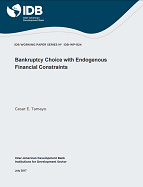Bankruptcy Choice with Endogenous Financial Constraints
Date
Jul 2017
In this paper we study firm dynamics and industry equilibrium when firms under financial distress face a non-trivial choice between alternative bankruptcy procedures. Given limited commitment and asymmetric information, financial contracts specify default, renegotiation and reorganization policies. Renegotiation entails a redistribution of social surplus, while reorganization takes the form of enhanced creditor monitoring. Firms with better contract histories are less likely to default, but, contingent on default, firms with better outside options successfully renegotiate, in line with the empirical evidence. Unless monitoring is too costly, renegotiation leads to reorganization, which resembles actual bankruptcy practice. We calibrate the model to match certain aspects of the data on bankruptcy and firm dynamics in the United States. Our counterfactual experiments suggest that poorly designed bankruptcy arrangements can increase substantially the fraction of firms facing financial constraints, with sizable negative implications for aggregate output and TFP.



